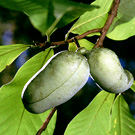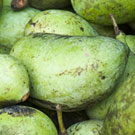Pawpaw Trees for Sale
Asimina triloba, or the pawpaw fruit tree, is a member of the custard apple family, Annonaceae. Pawpaw is a deciduous tree that has a narrow, conical growing habit reaching heights between 12 and 20 feet. The leaves are dark green and oblong, extending up to 12 inches in length. The dark brown flower buds turn into maroon flowers that are about 2 inches across and upside down. Pawpaw fruits are the largest native edible fruit in the USA. The seeds are about a half inch to an inch and a half long and shaped similarly to lima beans. The fruits also typically grow in clusters of up to 9 individual pawpaws. Willis Orchards has a large inventory of PawPaw trees for sale that yield delicious fruit that is soft with thin skin when fully ripe. Young plants are very sensitive to full sunlight and will do best with filtered sun for the first few years but will love full sun when mature.
When you buy PawPaw trees and plants online, keep in mind that the large leaves of the Pawpaw also do not typically do well in windy areas. They do best in fertile soil that will stay moist but drains well. Most pawpaw tree varieties also prefer a pH range between 5.0 and 7.0. Minimal pruning will be required to remove dead wood and damaged branches. Also, some periodic pruning may be good for fruit set since the fruits appear on new growth. Pawpaws are mostly disease free and have an innate resistance to Oak Root Fungus. They are not pollinated by bees, and instead rely on a series of flies and beetles, which can create an issue for home gardeners not getting proper fruit set. The easiest way to remedy the pollination issues is to hand pollinate using a soft artist's paintbrush to transfer the pollen from the flowers of one tree to the other.
The Paw Paw is a true native American fruit tree indigenous to the entire eastern half of America, from Texas to the Great Lakes and down the east coast to Florida. The Paw Paw is rarely seen and hardly known by recent generations, but was a household name for the pre-baby boomer generations. Many old and now forgotten folk songs were sang praising the Paw Paw. Being the largest edible fruit native to America, the Paw Paw is worth singing about and has found some resurgent interest in the past 20 years.
The fruit starts out green and in the oblong shape of a mango. It grows 3-6 inches long and ripens into a golden-brown with black splotches. It ripens from mid-August to October and should be soft enough to come off the tree with a gentle squeeze. The ripe Paw Paw will have a pronounced perfumed fragrance. The highly nutritious flesh will have a consistency of custard and a unique flavor, resembling a vanilla banana blend. The Paw Paw tree requires two for good pollination and heavy fruit set. It also requires approximately 400 chill hours to set fruit. The Paw Paw tree is small and handsome addition to an edible landscape. The Paw Paw tree is an understory tree in the forest and prefers to be planted in partial sun. Willis Orchard Company offers this native American treasure in hopes that you may find a spot in your home garden to bring back the glory of this fine and delicious native fruit so that future generations may sing songs about "pickin' up paw paws puttin 'em in a basket."

